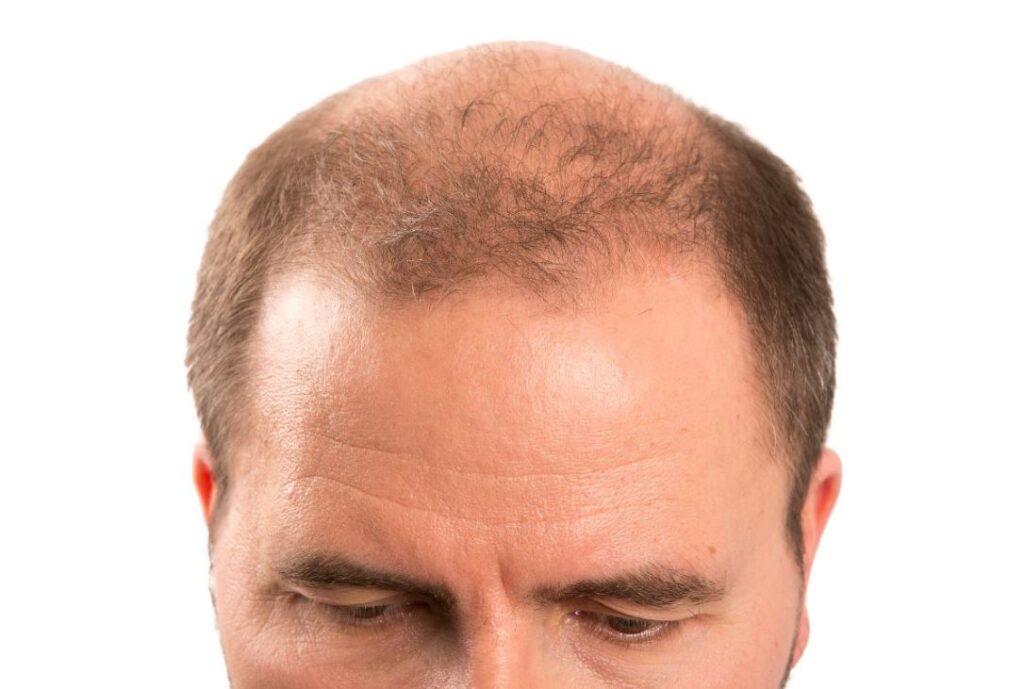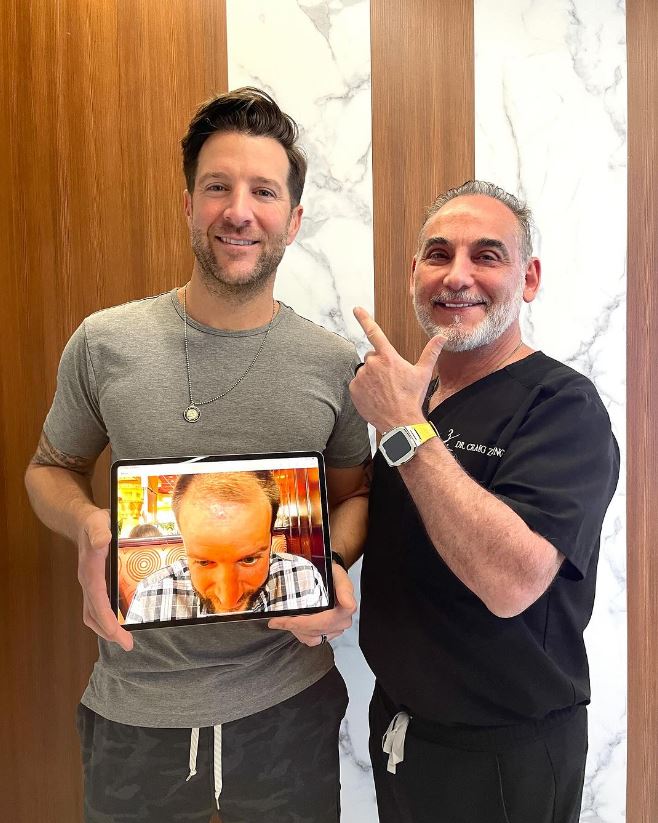How to Stop Balding in Men and Women

Worried about going bald? Discover clinically proven treatments to reclaim a fuller head of hair.
The American Hair Loss Association estimates that by age 35, two-thirds of American men will experience some degree of balding, and roughly 40% of women will have noticeable hair thinning by their 50’s. It’s no surprise then, that hair loss can lead to feelings of shame and hold people back from social interactions.
If you’re actively looking for ways to reverse hair loss, you must have considered nonsurgical treatments. But which treatments are most effective? Read more to find out.
Types of Hair Loss
Every day, we shed 100-150 hairs as new ones grow in their place. It’s a continuous process that maintains a healthy head of hair. However, when hair loss becomes excessive or follows a specific pattern, it might be a sign of an underlying condition.
There are two main categories of hair loss, each with different causes, but other less common types can also occur:
Androgenetic Alopecia
This is the most common type. Genetic hair loss is hereditary and linked to the hormone dihydrotestosterone (DHT). DHT shrinks hair follicles on the scalp, shortening the hair growth phase which causes hair to become thinner and finer hairs over time that eventually stop growing altogether. This explains the characteristic receding hairline in men and the general, diffuse thinning or widening of the hair part experienced by women.
Telogen Effluvium
This temporary hair loss can be triggered by various factors, including:
- Stress (physical or emotional)
- Illness (especially high fevers or chronic conditions)
- Certain medications (chemotherapy drugs, blood thinners, antidepressants)
- Childbirth
- Drastic dietary changes or malnutrition
- Crash dieting
Telogen effluvium disrupts the normal hair growth cycle, pushing a larger number of follicles into the resting (telogen) phase prematurely. This results in noticeable hair shedding, usually 2-3 months after the triggering event. The good news is that telogen effluvium is often temporary. Once the underlying cause is addressed, the hair growth cycle typically returns to normal, and hair loss stops.
Other types of hair loss:
Traction Alopecia: This is caused by repeated or long-term pulling or tension on the hair follicle. Tight hairstyles like braids, cornrows, or ponytails worn too tightly for extended periods can lead to traction alopecia.
Alopecia Areata: This autoimmune disorder causes the immune system to attack hair follicles, leading to sudden, patchy hair loss on the scalp or other hair-bearing areas like the eyebrows or beard. It can affect people of all ages and can be very unpredictable.
Scarring Alopecia: This type of hair loss occurs when the scalp is permanently damaged by injury, burns, infections (like fungal infections of the scalp), or certain medical procedures like radiation therapy. Scar tissue replaces healthy hair follicles, preventing hair growth in those areas.
Can Hair Loss be Reversed?
The possibility of reversing hair loss depends on its cause and severity. While some types of hair loss, such as stress-related hair loss, may resolve spontaneously or respond well to treatment, others, like pattern baldness, will require ongoing management to slow down the progressive nature of genetic hair loss and promote hair regrowth.
Many patients with pattern hair loss or genetic hair loss, are good candidates for hair transplant surgery; however, they will continue to lose their native hair and a treatment strategy for managing and maintaining their hair will be key.
Currently, there is no cure to fixing baldness permanently. But new studies show promising applications of stem cells for treating hair loss. Ziering Medical is proud to offer the world’s first non-invasive, follicle-based cell preservation solution in partnership with Acorn Biolabs.
This stem cell banking service involves collecting cells from plucked hair follicles and cryogenically freezing them. This process preserves younger cells, stopping them from aging and making them available for future regenerative treatments.
Learn More About Stem Cell Banking.
Best Treatments to Stop Balding Without Surgery
1. Oral and Topical Medications
Ziering Medical offers prescription treatments such as oral medications, like the ZPro, a form of finasteride, oral minoxidil, and dutasteride as well as medical grade topicals like Formula ZFin and Formula ZMin.
These treatments have been clinically proven to stop hair loss and regrow hair. It generally takes 3 – 4 months to see the initial results, and your results only last as long as you continue to take or use these prescription hair loss treatments. It’s important to remember that these treatments are available by prescription only and require a consultation with one of our Ziering hair restoration specialists.
2. Z-Factors
Z-Factors is a topical treatment loaded with powerful hair growth factors, cytokines, and other supportive elements. Unlike PRP (Platelet-Rich Plasma) therapy, Z-Factors eliminate the need for blood draws and injections, making it a more convenient and potentially less intimidating option.
It offers several benefits including slowing down hair follicle miniaturization, improving hair caliber and thickness, and enhancing overall hair health. This treatment is quick, in-office, and requires no downtime.
3. Laser Therapy
Both in-clinic laser therapy and at-home devices, such as the Ziering Lasercap, utilize low-level laser therapy (LLLT) to improve blood circulation, reduce inflammation, and enhance cellular activity in the scalp.
Consistent use of laser therapy devices can slow down hair loss and stimulate new hair growth. Your Ziering physician may use laser therapy in combination with other treatments like oral and topical medications to maximize your results.
Do These Treatments Work for Women’s Hair Loss?
Yes. When appropriate, these treatments are recommended for both men and women based on their individual needs and if they are a good candidate. However, medications like finasteride are not suitable for women who are in their childbearing years.
Watch Dr. Ziering talk about women’s hair loss at KTLA 5 News.
What About Hair Transplantation?
Hair transplantation remains to be the best option for individuals seeking a permanent solution to hair loss. There are two main types of hair transplant techniques:
Follicular Unit Extraction (FUE)
With FUE, the entire back and sides of the head must be shaved short. Then, each hair graft is directly harvested one at a time from the donor area using a punch device and transplanted into the recipient sites.
Recovery is generally quicker, with less discomfort and no linear scar. FUE still leaves tiny “dot-like” scars, which can be easily concealed by the surrounding hair. This method is particularly suitable for those who prefer shorter haircuts.
Microscopic Dissection Elliptical Excision (MDEE)
Using the MDEE technique (formerly FUT), a strip of tissue is surgically removed from the donor area, then dissected into individual hair follicle units under microscopes. These units are implanted into small incisions made in the balding or thinning areas of the scalp.
Though more invasive than FUE, MDEE typically allows for transplanting a larger number of grafts in one session, making it a cost-effective solution for extensive hair loss. The main drawback is the linear scar left in the donor area, but when performed by skilled surgeons like the Ziering Medical Team, this scar is nearly invisible.
Commonly Asked Questions About Hair Loss
- What foods prevent hair loss?
While no single food can guarantee hair growth, a balanced diet rich in protein, iron, biotin, and vitamins A, C, D, and E can promote overall hair health. Consider incorporating lean protein sources, leafy greens, fruits, nuts, and whole grains into your diet.
- Does hair dye cause hair loss?
Frequent chemical processing, like harsh dyes or perms, can damage hair and lead to breakage. This might be mistaken for hair loss. Opting for gentler hair coloring techniques and deep conditioning treatments can help minimize damage.
- What deficiency causes hair loss?
Deficiencies in iron, vitamin D, biotin, and protein can contribute to hair loss. A blood test can help determine if a deficiency is present, and a doctor can recommend supplements if needed.
Best Hair Transplant Clinic in NYC
Ziering Medical remains to be the premier hair transplant clinic in New York. Our hair transplant surgeons led by Dr. Craig Ziering offer some of the best hair transplant results in the country.
Call us to book a consultation at Ziering Medical. We serve patients all over the greater Tri-state area of New York, New Jersey, and Connecticut as well as the greater Southern California area from Los Angeles and Beverly Hills to Newport Beach and San Diego.
Hair Transplant Before and After

